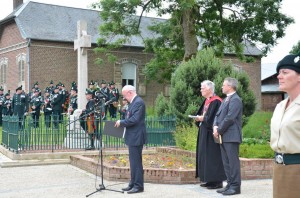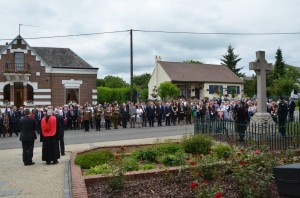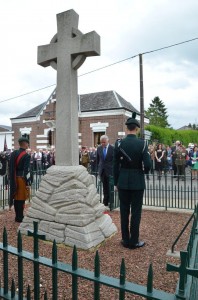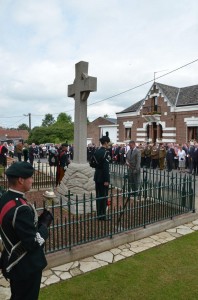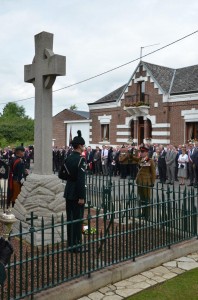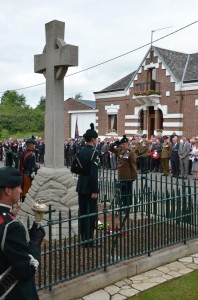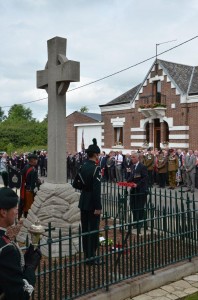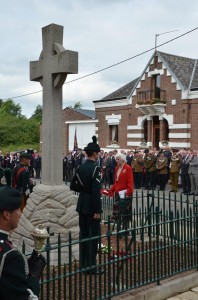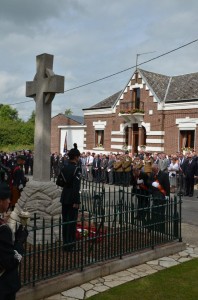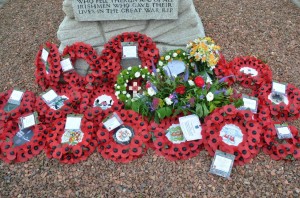DE LA PART DE L’ASSOCIATION DE LA SOMME, JE TIENS À VOUS REMERCIER DE VOTRE ACCUEIL AUJOURD’HUI A GUILLEMONT AINSI QUE DE L’HOSPITALITÉ GENEREUSE QUE VOUS NOUS AVEZ OFFERTE. NOS AMIS FRANCAIS NOUS HONORENT TOUJOURS ET NOUS SOMMES CONSCIENTS DU FAIT QUE LES FILS D’ULSTER ET D’IRLANDE QUI REPOSENT EN PAIX ICI SONT DEVENUS PLUS QUE DES FILS D’ULSTER ET D’IRLANDE. CE SONT MAINTENANT DES FILS DE LA FRANCE.
Here at Guillemont and neighbouring Ginchy, Redmond’s 16th (Irish) Division lost heavily in the first ten days of September 1916 with casualties of 240 of its 435 officers and 4090 of 10410 other ranks among its infantry and engineer units. Two-thirds of these were wounded, another fifth missing, with the remaining 650 killed in action. Among the 9thDublin Fusillers were Private James Liddy of Amiens Street, a well known Dublin confectioner, as well as Ginchy’s best known casualty, Lieutenant Tom Kettle.
(A memorial to Tom Kettle by Francis W. Doyle-Jones stands in St. Stephen’s Green in Dublin. It quotes lines from a sonnet he penned to his daughter shortly before his death (‘To My Daughter Betty’):
Know that we fools, now with the foolish dead,
Died not for the flag, nor King, nor Emperor,
But for a dream, born in a herdsman’s shed,
And for the secret Scripture of the poor.)
On 31st July 1917, during the third battle of Ypres, Francis Ledwidge of the Royal Inniskilling Fusilliers was engaged in road making with many others when he was blown to bits with six other soldiers by a German shell. He had fought everywhere from Suvia Bay in the Dardanelles to Serbia to France and Belgium. But he was killed suddenly and almost by accident drinking tea with his friends. Born the son of an immigrant farm labourer in 1897, Ledwidge claimed the noble heritage of the dispossessed Irish peasantry. While he wrote ardently of nature and the pastoral grandeur of his native Boyne Valley, his short life – as a local political representative, an activist of the Irish Volunteers – was a passionate testimony on human rights. Although he is best known for his moving tribute to Thomas MacDonagh, Ledwidge himself was fighting in France during the 1916 rising. “I joined the British Army” he said, “because she stood between Ireland and an enemy to our civilisation, and I would not have her say that she defended us while we did nothing at home but pass resolutions.”
The poetry of Francis Ledwidge evokes an Ireland of traditional nostalgia. But Seamus Heaney had said of Ledwidge that his fate was more complex and more modern, his moral courage alone gave him “membership in the company of the walking wounded, wherever they are to be found at any given time.” He was buried, No 5, in row B of the second plot in Artillery Wood Cemetery, about 3 miles North of Ypres in Belgium, and has joined the ranks of such fellow poets as Wilfrid Owen, Julian Grenfell, Rupert Brooke and Siegfried Sassoon.
As a tribute to these fellow poets who fought and died in the Great War, known and unknown, let me read one of his last poems:
After the War
Now is the story over
Over the grief and pain
And down in the purple clover
The red lips meet again
But one in the dewy shadows
Waited through all the noon
And they told her out of the meadows
Someone was coming home
Some lips spoke of tomorrow
And someone of yesterday spoke
But O! the heart in sorrow
On the rocks of trouble broke
I longed for to sing delighted
And laugh with the newly gay
But a gloom on my soul alighted
And would not go away.
To the sons of Ulster and Soldiers of Ireland we say:-
“Sons of Ulster, Soldiers of Ireland do not be anxious. The war is over – both here and in your beloved Ireland. The Western Front is no more and Ireland at last is at peace with herself and with her people. We will always remember you, so long as the sun shines and the rain falls and the wind blows and the great river Somme runs gently to the sea”.
Innui, deir muid le fir Uladh agus le fir na hÉireann:-
“A Fheara Uladh agus a Shaighdiúirí na hÉireann, ná biodh imni oraibh. Tá an Cogadh thart – ní amháin san áit seo, ach in bhur dtír dhílis féin in Éirinn. Níl an Fronta Thiar ann níos mó, agus, so deireadh, tá tír na hÉireann faoi shíocháin léi féin agus len a pobal. Ach chomh fada is a shoilsíonn an ghrian, agus a thiteann an fhearthainn, agus a shéideann an ghaoth, agus chomh fada is a théann abhainn mhór an Somme go caoin chun na farraige, bedh cuimhne againn araibh go deo”.
GUILLEMONT 1st JULY WREATH LAYING SEQUENCE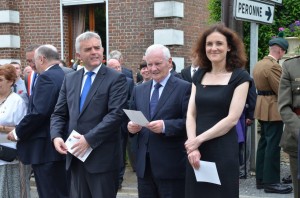
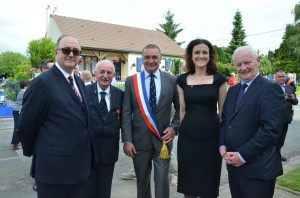 SECRETARY OF STATE FOR NI, RT HON THERESA VILLIERS MP
SECRETARY OF STATE FOR NI, RT HON THERESA VILLIERS MP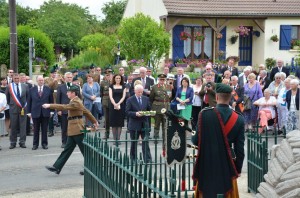
DINNY McGINLEY TD, IRISH MINISTER OF STATE FOR IRISH GAELTACTH AFFAIRS
JONATHAN BELL MLA ON BEHALF OF FIRST MINISTER FOR NI
MIKE NESBITT LEADER OF THE ULSTER UNIONIST PARTY
MAYOR OF GUILLEMONT AND MAYOR OF GINCHY
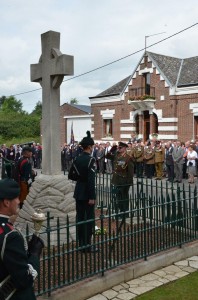 BRIG GEN TOM BEHAN IRISH DEFENCE FORCE
BRIG GEN TOM BEHAN IRISH DEFENCE FORCE
BRIG RJ THOMSON COMD 38 (IRISH) BDE
MAJ G SEMPLE 2nd BATTALION THE ROYAL IRISH REGIMENT
LT COL (Retd) CHARLIE BENNETT SOMME ASSOCIATION
OTHER WREATHS WERE NOW LAID BY ORGANISATIONS LED BY REPRESNTATIVES OF LOCAL AUTHORITIES IN NORTHERN IRELAND
THE FINAL WREATH WAS LAID BY RANGER HASSARD AT THE FRENCH MEMORIAL
